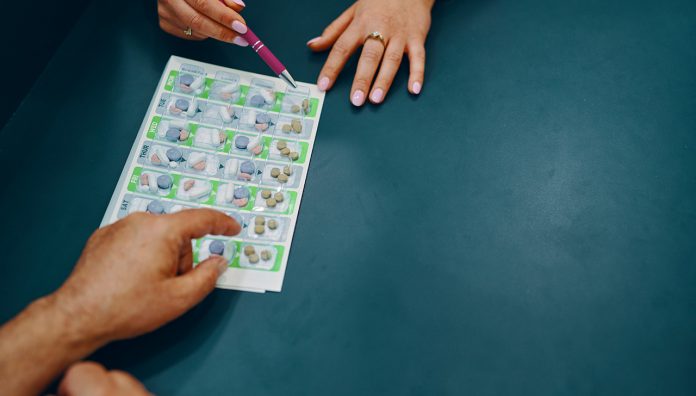A new intervention will target medicine safety in primary care, with the aim of reducing medicine-related hospitalisations by identifying at-risk patients.
The project, co-led by Dr Jean Spinks from Griffith University’s Centre for Applied Health Economics and Professor Lisa Nissen FPS from the Queensland University of Technology School of Clinical Sciences, will use health record data to identify medicine-related issues before they lead to hospitalisations.
‘In Australia, 250,000 hospital admissions and 400,000 emergency presentations per year are due to potentially preventable medication-related hospitalisations,’ Dr Spinks said.
‘If something is preventable, primary care is the appropriate place to target medicine safety,’ she told Australian Pharmacist.

While medicine reviews and MedsChecks allow pharmacists to pick up medicine safety concerns, there are several barriers to addressing issues in a timely way in primary care.
‘We’ve got caps allowing one medicine review service per year, time constraints on pharmacists and doctors, and pharmacists aren’t remunerated to proactively look for potential concerns,’ Dr Spinks said.
At the same time, advancements in digital health platforms have opened up new ways of identifying people who are at risk of serious medicine-related problems.
‘This means we can get to those people in a timely way if we can change the structures, so that there’s time and money available for pharmacists to be able to concentrate on those activities,’ Dr Spinks added.
Pilot program
The year-long pilot phase is expected to begin next month, with the trial set to run for 3 years in Victoria and south-east Queensland.
Although the service will be designed to be delivered nationally if effective, the trial will have a special focus on ensuring culturally appropriate access for Aboriginal and Torres Strait Islander people, who may be on many medicines to treat chronic disease and have reduced access to healthcare.
The research teams will work with Primary Health Networks (PHN), partnering with Brisbane South PHN and the National Aboriginal Community Controlled Health Organisation to co-design the intervention.
‘This is something new for consumers, pharmacists and GPs, so it is important to ensure these groups have input into how the intervention will work,’ Professor Nissen said ahead of her appearance at PSA21 next month.
Also on the agenda is refining a set of clinical indicators to determine the interventions for the trial, which the researchers will work through with a steering group.
This might include preventing conditions such as gastrointestinal bleeding, cardiovascular events, asthma exacerbations or heart failure exacerbations, which commonly result in hospitalisations.
How it works
Software will be developed to identify at-risk people via medical records, which will populate a dashboard with individuals who meet the criteria.
If a patient is deemed at risk, the pharmacist will undertake appropriate action.
‘For example, a lab test might be ordered to [look at] international normalised ratio rates, or there could be an issue with overprescribing or underprescribing, in which case the pharmacist will contact the prescriber,’ Dr Spinks said.
Pharmacists will be remunerated for their activity, she added.
While the mode of contact between pharmacists and patients is still being developed, one option is notifications via MedAdvisor, another partner on the trial.
A shared platform for GPs and pharmacists that allows for the safe and streamlined flow of information will also be considered.
‘The one thing we all have in common at the moment is My Health Record (MHR) and while it’s not ready to be used as the sole piece of IT for this project, we do see in the future that you could leverage off [the platform], so there is the one source of wisdom for medicine safety issues that both pharmacists and GPs can access,’ Dr Spinks said.
To identify how best to display information to pharmacists and doctors, the Australian Digital Health Agency will also join the trial as a partner.
‘For example, you could have push and pull mechanisms for MHR, so pharmacists can upload information and provide push notifications back to GPs,’ Dr Spinks said.
Looking forward
The ultimate goal of the trial is to develop a nationally funded service, which would complement medicine reviews.
‘We wouldn’t see it as a substitute, because medicine reviews are [much] broader in scope and we will only be trialing a certain set of clinical indicators,’ Dr Spinks said.
‘[But] as the high-frequency hospitalisations change over time, we see the system as being adaptive and responsive to the public health needs of the population.’
Once pharmacists are funded to provide the service, they can adjust their workflow or adapt their rostering, depending on the needs of their practice.
‘We would like to see a model where [community] pharmacists can take the lead on these types of issues, because medicine safety is right at the heart of what pharmacists do,’ Dr Spinks said.
‘This is basically systematising and removing some of the structural barriers, so pharmacists can focus more clearly on this issue.’
The cost-effectiveness of the service will also be tested as part of the trial, but Dr Spinks thinks it will work in their favour.
‘We would expect that if you are reducing hospitalisations, it’s likely to be cost-effective to pay pharmacists to be proactive in this area,’ she said.



 John Jones MPS, pharmacist immuniser and owner of My Community Pharmacy Shortland in Newcastle, NSW[/caption]
John Jones MPS, pharmacist immuniser and owner of My Community Pharmacy Shortland in Newcastle, NSW[/caption]


 Debbie Rigby FPS explaining how to correctly use different inhaler devices[/caption]
Debbie Rigby FPS explaining how to correctly use different inhaler devices[/caption]




 Professor Sepehr Shakib[/caption]
Professor Sepehr Shakib[/caption]

 Lee McLennan MPS[/caption]
Lee McLennan MPS[/caption]
 Dr Natalie Soulsby FPS, Adv Prac Pharm[/caption]
Dr Natalie Soulsby FPS, Adv Prac Pharm[/caption]
 Joanne Gross MPS[/caption]
Joanne Gross MPS[/caption]





